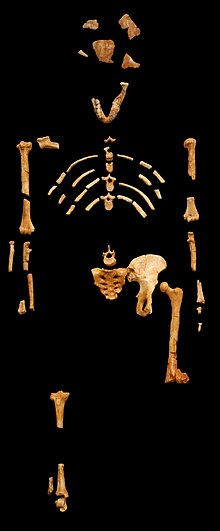Australopithecus afarensis
Ìrísí
| Australopithecus afarensis Temporal range: Pliocene
| |
|---|---|

| |
| Cast of the remains of "Lucy" | |
| Ìṣètò onísáyẹ́nsì | |
| Ìjọba: | |
| Ará: | |
| Ẹgbẹ́: | |
| Ìtò: | |
| Ìdílé: | |
| Subfamily: | |
| Ìbátan: | |
| Irú: | A. afarensis
|
| Ìfúnlórúkọ méjì | |
| Australopithecus afarensis | |
Australopithecus afarensis is an extinct hominid which lived between 3.7 and 2.9 million years ago.[citation needed] A. afarensis was slenderly built, like the younger Australopithecus africanus. It is thought that A. afarensis was ancestral to both the genus Australopithecus and the genus Homo, which includes the modern human species, Homo sapiens. The most famous fossil is the partial skeleton named Lucy (3.2 million years old) by Donald Johanson and colleagues, after they played the Beatles song Lucy in the Sky with Diamonds over and over in celebration of their find.[1][2][3](p234)

|
Àyọkà yìí tàbí apá rẹ̀ únfẹ́ àtúnṣe sí. Ẹ le fẹ̀ jù báyìí lọ tàbí kí ẹ ṣàtúnṣe rẹ̀ lọ́nà tí yíò mu kúnrẹ́rẹ́. Ẹ ran Wikipedia lọ́wọ́ láti fẹ̀ẹ́ jù báyìí lọ. |
Itokasi
[àtúnṣe | àtúnṣe àmìọ̀rọ̀]- ↑ Johanson & Maitland 1981, pp. 283–297
- ↑ Johanson, D.C. (2009). "Lucy (Australopithecus afarensis)". In Michael Ruse & Joseph Travis. Evolution: The First Four Billion Years. Cambridge, Massachusetts: The Belknap Press of Harvard University Press. pp. 693–697. ISBN 978-0-674-03175-3.
- ↑ Wood, B.A. (1994). "Evolution of australopithecines". In Jones, S., Martin, R. & Pilbeam, D.. The Cambridge Encyclopedia of Human Evolution. Cambridge, U.K.: Cambridge University Press. ISBN 0-521-3270-3. Also ISBN 0-521-46786-1 (paperback).
